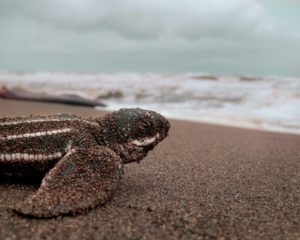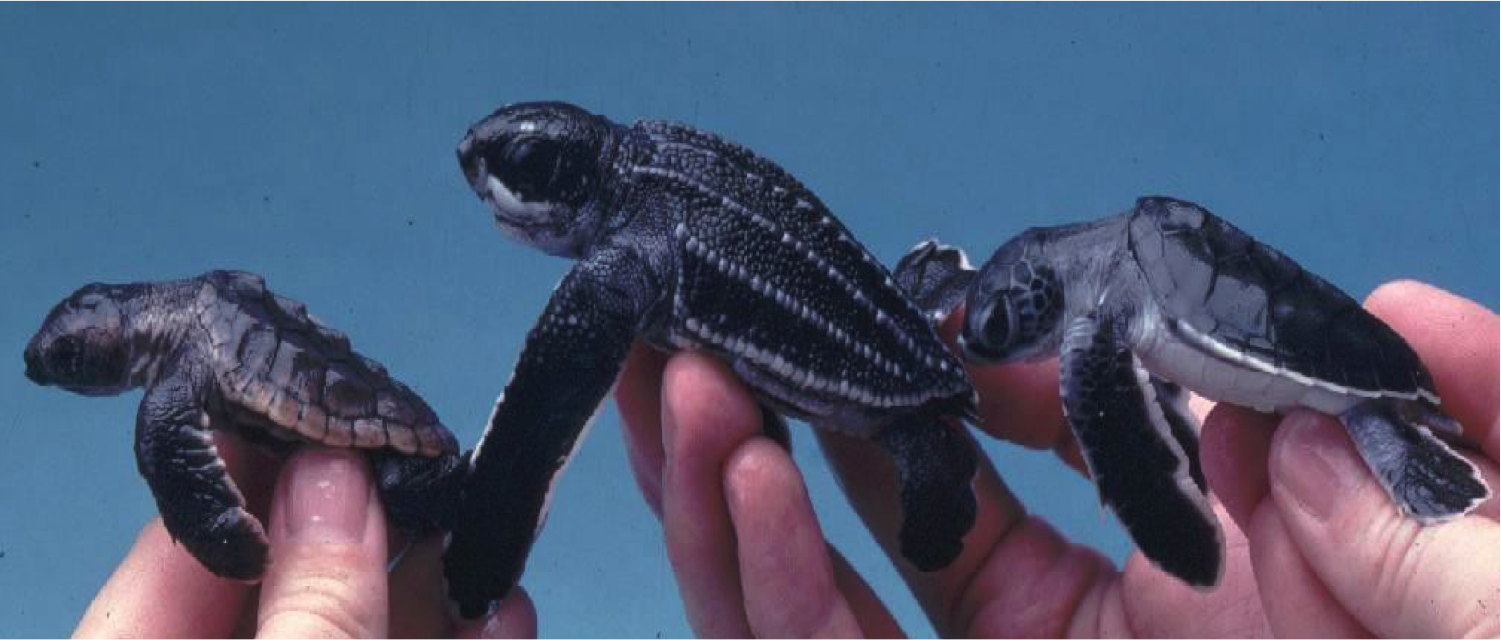Written by Sam Zlotnik
Edited by James Murray

For a sea turtle hatchling, getting to the ocean is critical. This behavior, called seafinding, is hardwired in all sea turtle species. Newly hatched turtles must find the ocean without getting eaten by predators or wandering off-course. And according to Dr. Mike Salmon, a biology professor at Florida Atlantic University, “Vision seems to be the major way in which all species of sea turtles find the ocean.”
At night, when most sea turtles hatch, the moonlight and starlight reflect off the surface of the water, creating a soft glow that acts as a beacon for the tiny turtles. On nights with a full moon and no clouds, following the ocean’s reflection is easy. But on nights with little moonlight, this strategy may be less effective.
Sam Trail, a graduate student researcher at Florida Atlantic University, explained that, contrary to expectations, sea turtles have eyes that are specialized for seeing during the day, not at night. “Their vision is not meant for darkness, which is funny because that’s when most seafinding is happening,” she noted, “based on how their eye is shaped and the anatomy…we know that for the most part, they’re built for bright light conditions.”
If we consider a sea turtle’s entire lifespan, most of which is spent swimming in the open ocean during the daytime, it makes sense that their eyes are adapted for daylight. But the hatchling sea turtles’ nighttime journey led scientists to wonder just how sensitive their eyes actually are to dim lights.
Lisa Celano, another researcher at Florida Atlantic University, decided to answer this question by running a behavioral experiment with two species of sea turtles: loggerheads and green turtles. While working with Salmon and other colleagues, Celano collected sea turtles of both species as soon as they hatched and took them back to the lab. There, the hatchlings were placed in a two-armed maze shaped like the letter “Y”.
During each trial, a light was turned on in one arm of the maze, while the other arm was left in darkness. If turtles could perceive the light, they would quickly crawl towards it, but if not, they showed no preference for either arm of the maze. By repeating the trials with different light intensities, Celano could determine how dim a light needed to get before the turtles failed to detect it.

This experiment, which was published in the Journal of Comparative Physiology A, demonstrated that both loggerhead and green sea turtles had similar light sensitivity. Both turtles had vision that far surpassed what was necessary to detect reflected celestial light, even on moonless nights.
Although both loggerheads and green turtles showed this pattern, it was not clear if all sea turtles shared their same degree of light sensitivity. Sam Trail and Mike Salmon decided to take on the challenge of replicating this experiment with the highly unique leatherback sea turtles. Leatherbacks are the most distantly related species to all other sea turtles, and they differ dramatically in their size, shape, and behavior. As Salmon explained, “We’re just touching sort of the tip of the iceberg in terms of trying to understand what’s going on with leatherbacks in general.”
Trail started by collecting baby leatherbacks and testing them in the same way that Celano had tested the loggerhead and green turtle hatchlings. While the first two species were nearly identical in their light sensitivity, the leatherbacks showed a major difference. Trail was shocked to see that in the maze, the leatherbacks needed 10-100 times brighter light to be able to detect it than either the loggerheads or the green turtles. “It’s still baffling to us,” she said, “I’m not afraid to admit that this is not at all what we really anticipated to see.”
Despite the unique features of adult leatherbacks, such as their massive size and their jellyfish-only diet, hatchlings have the same seafinding challenge as other sea turtles. Because of this shared behavior, the researchers expected their vision to be similar as well. “You’d think that if there were differences, sensitivity wouldn’t be one of them,” Salmon noted.
One potential reason for the difference between leatherback vision and that of other sea turtles is the unique lifestyle of adult leatherbacks. As adults, these turtles travel to much colder, deeper, and darker waters than other turtles so that they can snack on huge “blooms” of jellyfish. Trail noticed that the leatherback hatchlings seemed to be most sensitive to light at the wavelengths that penetrate deep underwater. But this explanation still does not explain why leatherbacks have such low sensitivity overall compared to loggerhead or green turtles, and what that means in practice for their seafinding ability.

To test how leatherbacks’ light sensitivity affects their seafinding, Trail ran a second study out on the beach. She went out on full moon and new moon nights and collected both loggerhead and leatherback hatchlings. She placed each hatchling on the sand and recorded which way it crawled. On full moon nights, all the hatchlings went straight for the ocean with hardly any errors. But on new moon nights, the leatherbacks often crawled in the wrong direction or in circles rather than making a beeline for the ocean like the loggerheads did.
This study showed that, without bright moonlight, leatherback hatchlings are worse at seafinding than other sea turtle species. Unfortunately, artificial lights may make it even harder for sea turtles in general to find the ocean. When there is little contrast between reflected natural light and artificial lights, turtles may not be able to orient correctly towards the ocean. Trail noted that “there are very few pristine, 100% natural beaches that aren’t exposed to these sky glows and artificial lighting.”
For leatherback hatchlings, this problem could be much worse than for other sea turtles. As Salmon explained, “We think one of the consequences of their lack of comparable sensitivity is that they are going to be more easily disrupted by artificial lighting.” Given that leatherbacks are an endangered species, scientists will need to move quickly to determine exactly how hatchlings are impacted by artificial lights and how best to protect them.

About the author:
Sam Zlotnik is a behavioral ecologist, evolutionary biologist, and science writer. They are currently a PhD student at the University of Florida where they study feeding behavior and mouthpart development in leaf-footed bugs. You can read more of Sam’s writing at samzlotnik.weebly.com and follow them on Twitter at @SamZlotnik.

